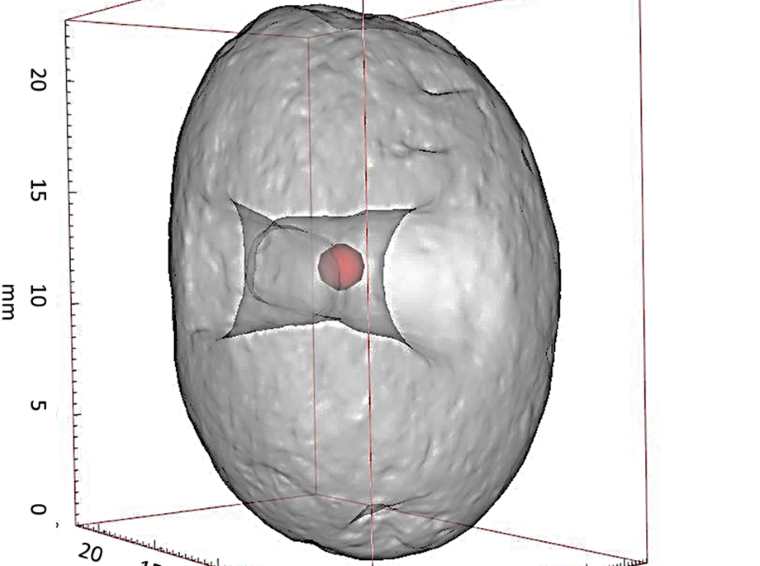New research published in the journal PLOS ONE suggests that 12,000-year-old stones discovered in Israel may be the earliest evidence of the mechanical principle of the wheel.
Most archaeologists place the formal invention of the wheel and axle used in carts to the Bronze Age, which began thousands of years after the recently discovered stones were used.
Now, according to the authors of the study outlining the analysis of the recently discovered stones, the foundational technology behind the wheel and axle may have been discovered thousands of years earlier.
“While its ancient origins are commonly associated with the appearance of carts during the Bronze Age, we focus on a much earlier wheel-shaped find–an exceptional assemblage of over a hundred perforated pebbles from the 12,000-year-old Natufian village of Nahal Ein-Gev II, Israel,” the study authors write.
Although the research team’s analysis did not support the idea that these particular stones were used as a formal wheel and axle, they determined they were likely not ornamental. Instead, the authors suggest that these perforated stones were specifically designed for spinning fibers, a wheel and axle design predecessor technology.
“We conclude that these items could have served as spindle whorls to spin fibres,” they write. “In a cumulative evolutionary trend, they manifest early phases of the development of rotational technologies by laying the mechanical principle of the wheel and axle.”
What is the Purpose of the 12,000-Year-Old Stones?
The stones used in the study were found at the Nahal Ein-Gev II archaeological site, located about 2 km east of the Sea of Galilee in the Jordan Valley. The site was named due to its location on the banks of the Ein-Gev Wadi.
According to the study authors, Talia Yashuv and Leore Grosman from the Hebrew University of Jerusalem, Israel, 133 of the 12,000-year-old stones were discovered over several digs dating back to 1972, when six perforated stones were excavated during a test excavation. The remaining 107 stones were unearthed between 2010 and 2021.
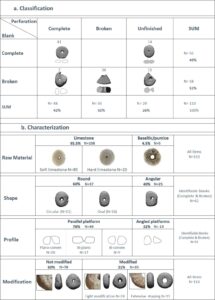

An initial analysis allowed the researchers to divide the stones into three distinct groups “according to the state of perforation.” The first group contained 48 stones with “complete perforation,” the second group had 36 broken stones “with partial holes,” and the final 29 stones were described as “unfinished items with one or two drill marks.” These unfinished stones led the researchers to propose that all 113 were made locally.
To determine the function of the 12,000-year-old stones, the team considered the various uses ascribed to similarly perforated ancient stones. According to the authors, such early perforated stones are “most commonly understood” as “beads, loom weights, fishing nets, mace heads, and spindle whorls.”
Next, the researchers used 3D modeling software to scan the beads individually. According to the authors, these scans created a “full 360° view of the perforations,” which allowed them to “describe and measure attributes unattainable otherwise.”
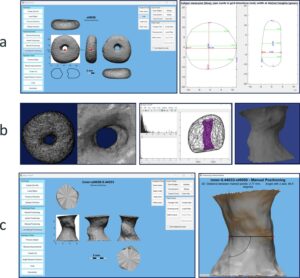

For example, the team was able to determine whether the shape of the perforations on the stones was biconical or flat and whether or not the meeting point between opposing drills was central, offset, or at the edge. They could also determine whether the aperture was round, oval, or asymmetric and the similarity level of the two opposing apertures.
According to the authors, this analysis showed that the stones “were bi-directionally drilled, have a minimal meeting point between the opposing drills that is preferably centered at their mid-thickness, and have a relatively constant minimal width.”
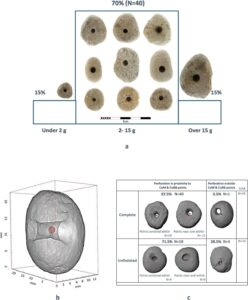

After comparing the data from their analysis with perforated stones used for varying reasons, the team determined that these stones best fit the designs of spindle whorls used to spin fibers to create yarn for clothes, blankets, and other fabrics. This likely use was confirmed by successfully spinning fibers with the stones.
“The persisting choice of perforating pebbles at their centre of mass suggests that the composite tool is balanced and use of stick rather than string,” they write. “While drilling flywheels are noticeably heavier, and mace heads are mostly piriform in shape and weigh more than 150, spindle whorls that act as flywheels to enhance rotation momentum when spinning fibres to yarn fit best.”
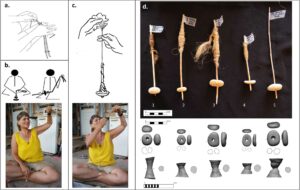

Finding a Link Between Ancient and Modern Technology
In the study’s conclusion, Yashuv and Grosman reiterate that their discovery of 12,000-year-old stones used as spinning whorls does not suggest that these ancient Neolithic people invented the wheel. Instead, they argue that these perforated pebbles “provide evidence of a 12,000-year-old wheeled-shaped tool” was successfully integrated into a mechanical rotational mechanism.
“We suggest, therefore, that spindle whorls, including those from NEG II, relate to the evolution of the ensuing rotational technologies by laying the mechanical principle of the wheel and axle,” they conclude.
Perhaps even more significant, the study authors summarize several technological innovations taking place around this same time, such as the production of high-quality lime plaster, the presence of storage installations, the use of hafted flint perforators for fast drilling, the production of disc-beads, and increasingly organized hunting habits, show that Stone age people were undergoing a widespread societal evolution that included the perforated stones. The authors also note how understanding the technology of these ancient people can help draw a line between their lives and ours.
“The most important aspect of the study is how modern technology allows us to delve deep into touching the fingerprints of the prehistoric craftsman, then learn something new about them and their innovativeness, and at the same time, about our modern technology and how we’re linked.”
The study, “12,000-year-old spindle whorls and the innovation of wheeled rotational technologies,” was published in PLOS ONE.
Christopher Plain is a Science Fiction and Fantasy novelist and Head Science Writer at The Debrief. Follow and connect with him on X, learn about his books at plainfiction.com, or email him directly at christopher@thedebrief.org.
